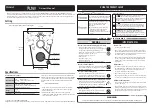
VNA concepts and features
R&S
®
ZNL/ZNLE
250
User Manual 1178.5966.02 ─ 19
Calibration Type
Standards
Parameters
Error Terms
General Accuracy
Application
TRL
(2-port)
Reflect (at both
ports),
Through, Line1,
other Lines
(optional), combina-
tion with TRM
(optional)
All
Reflection tracking,
Source match,
Directivity,
Load match,
Transmission track-
ing
High, high directiv-
ity
Reflection and
transmission mea-
surements, espe-
cially for planar cir-
cuits. Limited band-
width.
1)
Or any other 3 known one-port standards. To be used in a guided calibration, the known standards must be declared to be Open,
Short, and Match irrespective of their properties.
2)
Or any other known two-port standard. To be used in a guided calibration, the known standard must be declared to be Through,
irrespective of its properties.
The calibration type must be selected in accordance with the test setup. Select the cali-
bration type for which you can obtain or design the most accurate standards and for
which you can measure the required parameters with best accuracy.
Normalization (reflection, transmission)
................................................................250
....................................................................................251
One Path Two Ports Calibration
............................................................................251
................................................................................252
Complementary isolation measurement
................................................................255
9.5.1.1
Normalization (reflection, transmission)
A normalization is the simplest calibration type since it requires the measurement of
only one standard for each calibrated S-parameter:
●
One-port (reflection) S-parameters (S
11
, S
22
, ...) are calibrated with an Open or a
Short standard providing the reflection tracking error term.
●
Two-port (transmission) S-parameters (S
12
, S
21
, ...) are calibrated with a Through
standard providing the transmission tracking error term.
Normalization means that the measured S-parameter at each sweep point is divided by
the corresponding S-parameter of the standard. A normalization eliminates the fre-
quency-dependent attenuation and phase shift in the measurement path (reflection or
transmission tracking error). It does not compensate for directivity or mismatch errors.
This limits the accuracy of a normalization.
●
Manual reflection normalizations offer
Complementary Match standard measure-
●
Manual transmission normalizations support
Complementary isolation measure-
Calibration
















































